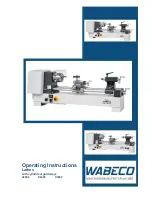
Fig 33
Remove bearing cover (D, Fig 34).
Note: Spindle lock (E) and spring will pop out.
Fig 34
Use a rubber mallet, to tap the spindle towards tailstock.
(also can use a piece of hard wood, or brass to protect the
spindle).
Fig 35
Go only far enough to remove the belt.
Fig 36
To reassemble reverse the procedure.
Note:
To avoid bearing overload, do not over tighten the handwheel.
Thread it on to the spindle until its snug, then back off slightly
and tighten the grub screws.
9. Trouble shooting
Motor fails to develop full power
*Power line overloaded-
Correct overload condition.
*Undersized wires in power supply system-
Increase supply wire size.
Motor or spindle stalls or doesn’t start
*No electricity-
check mains and fuse.
*Defective switch, motor or cord-
consult an electrician.
*Excessive cut-
Reduce depth of cut.
*Improper belt tension or worn belt-
Adjust or replace belt as needed
Machine vibrates excessively
*
Stands on uneven surface-
adjust stand for even support.
*Workpiece is not properly centred
*The speed is too high
*Motor mounting fasteners are loose
Tailstock moves when applying pressure
*Cam lock nut needs adjusting-
Tighten cam lock nut (see chapter 8.1)
*Bed and tailstock surfaces are greasy-
Clean surface and re-apply rust protection







































